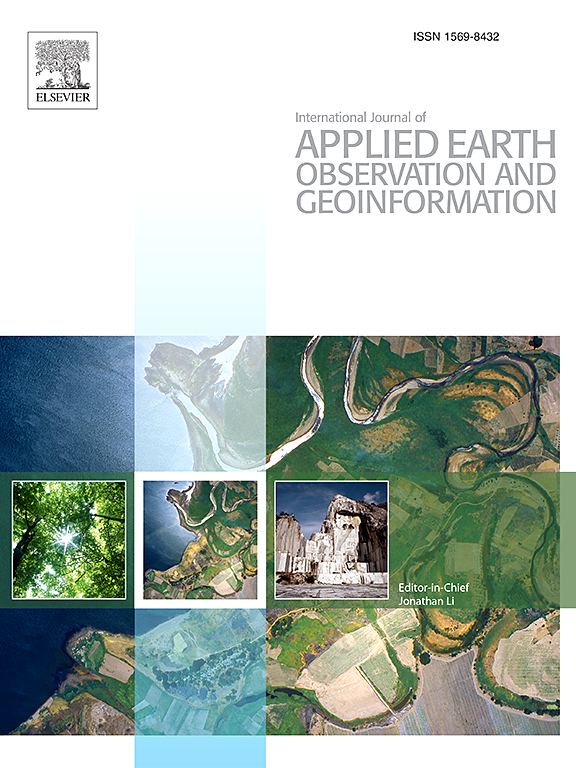DMP-PUNet: A novel network for two-dimensional InSAR phase unwrapping under severe noise and complex fringes conditions
IF 7.6
Q1 REMOTE SENSING
International journal of applied earth observation and geoinformation : ITC journal
Pub Date : 2025-04-08
DOI:10.1016/j.jag.2025.104519
引用次数: 0
Abstract
In the processing of Interferometric synthetic aperture radar (InSAR) data, two-dimensional (2-D) phase unwrapping (PU) is crucial for ensuring the quality of InSAR data inversion. Traditional methods, based on the assumption of phase continuity, often struggle with abrupt terrain changes and the influence of severe noise, leading to poor performance or failure. To address these challenges, this paper presents a dilated multi-path phase unwrapping network (DMP-PUNet) for 2-D PU under conditions of severe noise and complex fringes. To train this model, we developed a multi-effect interferometric phase simulation (ME-IPS) strategy that aims to simulate interferometric phases that closely resemble real-world conditions by comprehensively considering various factors, including terrain and digital elevation model (DEM) errors, atmospheric turbulence, vegetation effects, baseline geometry, multiple scattering, and noise. This simulation, combined with quasi-real interferometric phase data obtained from DEM inversion algorithms, forms the comprehensive training dataset. Finally, experiments on simulated data, quasi-real data, the InSAR-DLPU dataset, and InSAR data demonstrate that DMP-PUNet outperforms existing methods. For simulated data, DMP-PUNet achieved an overall average mean absolute error (MAE) in residuals of 0.221 rad, improving accuracy by 54.75 % with an average processing time of 0.81 s. For quasi-real data, the average MAE was 0.320 rad, a 119.06 % increase in accuracy, with an average processing time of 0.82 s. For the InSAR-DLPU dataset, overall, the MAE of DMP-PUNet was 20.34 % to 64.96 % lower than that of the best-performing baseline method (DLPU), with an average processing time of 1.90 s. For InSAR data, DMP-PUNet performed stably, with lower noise levels, smooth phase transitions, and deformation spatial patterns and profile shapes that conform to the laws of mining subsidence, averaging a processing time of 1.71 s, outperforming existing methods.
DMP-PUNet:一种用于严重噪声和复杂条纹条件下二维InSAR相位展开的新网络
在干涉合成孔径雷达(InSAR)数据处理中,二维相位展开(PU)是保证InSAR数据反演质量的关键。传统的基于相位连续性假设的方法,往往要与突如其来的地形变化和严重的噪声影响作斗争,导致性能差或失效。为了解决这些挑战,本文提出了一种适用于严重噪声和复杂条纹条件下二维PU的扩展多路径相位展开网络(DMP-PUNet)。为了训练该模型,我们开发了一种多效应干涉相位模拟(ME-IPS)策略,旨在通过综合考虑各种因素,包括地形和数字高程模型(DEM)误差、大气湍流、植被效应、基线几何形状、多重散射和噪声,模拟与现实世界条件非常相似的干涉相位。该模拟结合DEM反演算法获得的准实干涉相位数据,形成综合训练数据集。最后,在模拟数据、准真实数据、InSAR- dlpu数据集和InSAR数据上的实验表明,DMP-PUNet优于现有方法。对于模拟数据,DMP-PUNet在残差中的总体平均绝对误差(MAE)为0.221 rad,平均处理时间为0.81 s,精度提高了54.75%。对于准真实数据,平均MAE为0.320 rad,准确率提高119.06%,平均处理时间为0.82 s。对于InSAR-DLPU数据集,总体而言,DMP-PUNet的MAE比性能最佳的基线方法(DLPU)低20.34%至64.96%,平均处理时间为1.90 s。对于InSAR数据,DMP-PUNet表现稳定,具有较低的噪声水平、平滑的相变、符合开采沉陷规律的变形空间模式和剖面形状,平均处理时间为1.71 s,优于现有方法。
本文章由计算机程序翻译,如有差异,请以英文原文为准。
求助全文
约1分钟内获得全文
求助全文
来源期刊

International journal of applied earth observation and geoinformation : ITC journal
Global and Planetary Change, Management, Monitoring, Policy and Law, Earth-Surface Processes, Computers in Earth Sciences
CiteScore
12.00
自引率
0.00%
发文量
0
审稿时长
77 days
期刊介绍:
The International Journal of Applied Earth Observation and Geoinformation publishes original papers that utilize earth observation data for natural resource and environmental inventory and management. These data primarily originate from remote sensing platforms, including satellites and aircraft, supplemented by surface and subsurface measurements. Addressing natural resources such as forests, agricultural land, soils, and water, as well as environmental concerns like biodiversity, land degradation, and hazards, the journal explores conceptual and data-driven approaches. It covers geoinformation themes like capturing, databasing, visualization, interpretation, data quality, and spatial uncertainty.
 求助内容:
求助内容: 应助结果提醒方式:
应助结果提醒方式:


